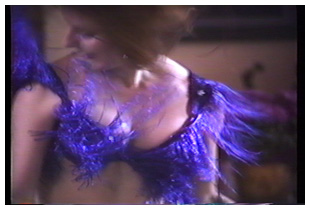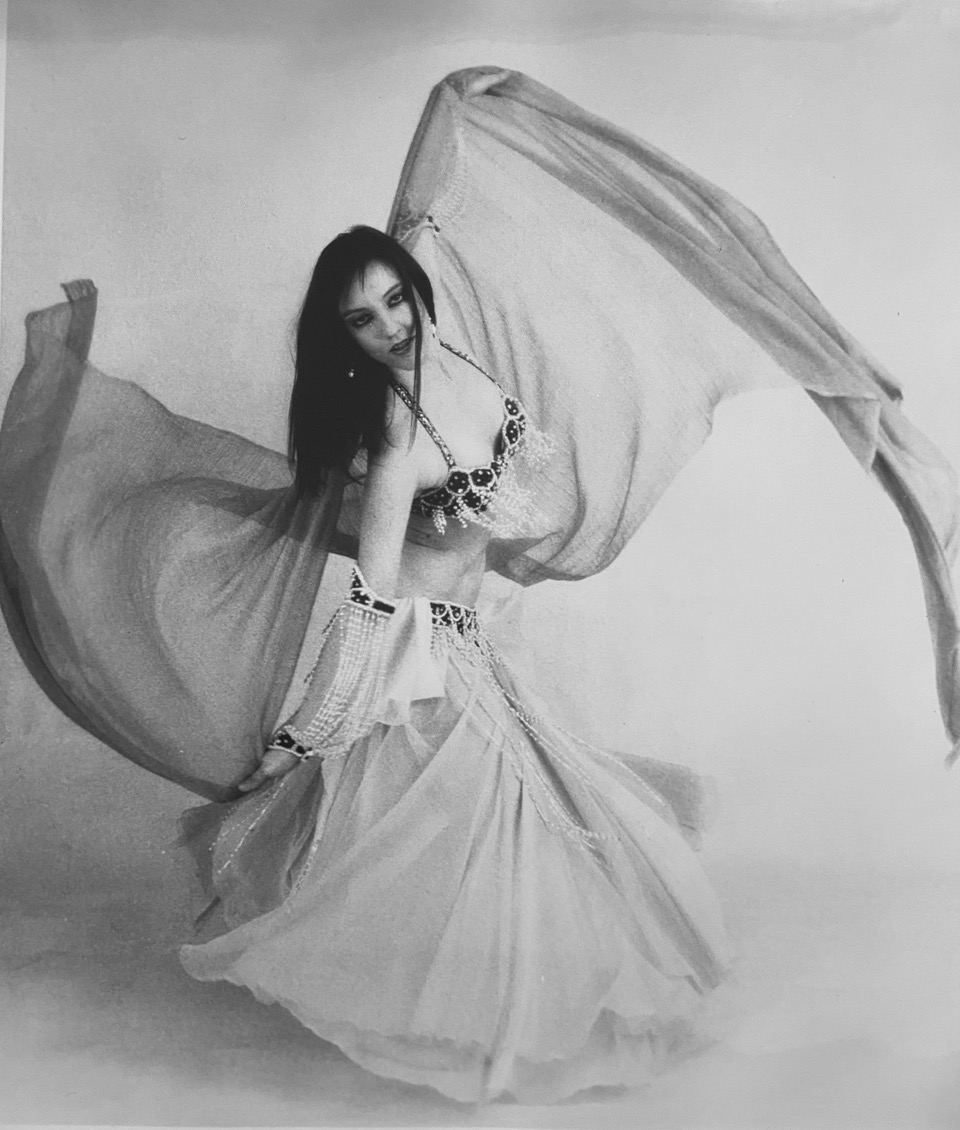Elena, Who Changed My Life

by Dunya Dianne McPherson
Fazil's Nightclub
Fazil’s nightclub on 8th Ave. and 48th St. was a hub of music and taxi drivers. Fazil bought the legendary Jerry Leroy studios in the late 70’s and has not done a single renovation to the four-story brick since. In fact I don’t think there has been a renovation since the building went up in 1901.
It was at one time rat-a-tatting with Broadway hoofers but when I mounted the rickety stairs it resounded with dumbek and finger cymbals. I saw a derelict leather couch and a desk behind which, with his back to me, a dark-haired man shouted Turkish into the phone above the din of dozens of pairs of flamenco shoes stampeding overhead in the upstairs studios. I don’t really know why there was a registration desk. No one was ever there to register students. Usually Fazil or one of the male accompanists sat at it tilting his chair against the wall covered with glamour photos of every belly dancer who had ever danced at the club – shiny black and white PR shots of women in standing or reclining poses wearing elaborately beaded bra-and-belt costumes and long chiffon skirts. Scrawled in ink across the corners, were loving dedications: “To Fazil, Thanks for everything! Love Delilah.”, “Fazil you’re the best! Love Samia”, ”To Fazil, the Master of Midnight. Love, Esmara,” or Eva, Serena, Jamila, Jihan or Zohar. The photos continued all the way around the walls of the stuffy corner, from floor to ceiling.
“You’re looking for class,” the man sitting at the desk stated rather than asked. He meant ‘a dance class’ but was probably right on both counts. He was gorgeous — white-haired with heavy-lidded chocolate eyes. They shone through a veil of smoke coming from the ashtray where he parked a cigarette on which, I sensed, he never took a drag. ”Yes. Who?” It was a deep voice, warm.
I was still catching my breath after a dash from the subway and up the stairs. Wearing modern dancer clothes — beat up black sweats, a long scarf wound many times around my neck, and running shoes, I felt very gauche, very provincial, very American. Everyone here, men and women, wore shoes with heels and long dark wool coats or abused, well-worn leather jackets. Men’s hair grazed the back of their collars. Sloe-eyed women sported sensuous ankle length skirts.
Fazil — the handsome man — noticed my discomfort and was kind. Right away I felt less like an ugly duckling, less like a boy-girl. I had come to learn how to be what I had been seeing at his nightclub every week for the past six months.
“I’m here for Elena’s class,“ I said, dropping my dance bag onto the blackened, cracked linoleum.
He nodded, “Sure. Sure.” His accent lengthened the vowel to something between an ’oooo’ and the short ‘u’ in ‘urn’. “I think she’s in that one.” He pointed with a head nod to the door behind me. “You never been here before?”
“Well, not here. I’ve come to the club a lot.” The club, another world altogether, was one floor down.
“Oh yes, I see you there I think. You come with a tall man?”
“Yes.” I was surprised he noticed. The club was always dark, smoky, and loud. How could anyone remember anything that wasn’t glittering under stage light? “The show is so good.” I gushed. “I really love it. Elena is amazing….” Everyone who saw her said this. She was the jewel in the nightclub’s crown, and one of the most remarked upon dancers in New York’s Middle Eastern dance scene.
Fazil smiled, gesturing, “The ladies’ dressing room is there.”
I slid through the barely open door into a crush of bodies changing in and out of dance and street clothes. It smelled of sweat, cheap perfume, stale deodorant, and hair spray. The bathroom stalls, I was to learn shortly, had no toilet paper and stank.
Elena's Class
I emerged quickly and walked into the studio to see Elena.
The Goddess! What other word is there for her? I had been going to the club every Friday and Saturday for four months to watch her forty-minute set at midnight. She would glide through the audience, trailing the scent of an expensive fragrance, and emerge into the glow of hazy stage light as Mehmet’s accordion crooned an Om Khalthoum tune redolent with promise. She took her time, assuming her opening pose. Heavy amber and blue lights glistened on the thick swatch of obsidian beaded fringe drooling over her shoulders, across her breasts like jeweled seaweed, her naked stomach barely visible below. Her head arched forward into a waterfall of glossy black hair. The music surged beneath her feet in a mighty river. She waited, drawing us to her stillness.
She jerked her head up, tossing the hair back. My breath caught. Her dark eyes cast into us like a liquid rising out of her viscera. Each show the same opening yet always astonishing, like a sunrise which every time is the most beautiful thing imaginable. Her finger cymbals began a slow steady roll. They growled in their ringing, fierce. A lioness prowling, her hips vibrating finely, nothing wild and unkempt but controlled and focused. She unleashed these steady, etched rhythms towards us in a cloud of dark opium presence.
Suddenly the shock of her naked ankle wreathed in beads kicked from beneath a froth of carnelian underskirt! She was bursting into flames underneath herself, red licking out of her otherwise entirely black attire. Her feet beat the floor in eddies of red and black silk as she edged forward and a red veil shot up to the sky from her fingertips. I don’t remember seeing how she did this. Where did this sudden conflagration of fabric come from?
I wanted to cry, but all I could do was gape and feel very humble that after 20 years of professional dancing I had rarely seen anything this good – anything this hot and this cool at once, this glamorous, this elegant, yet this electric. My lower chakras buzzed, my heart softened. I wanted to scream in raucous indignation to the dance world, “This dancer, who you do not deign to recognize because she is a belly dancer, is a national treasure!” But instead I kept showing up week after week to watch and absorb until I could no longer resist. I had to take her class.
Real Life
Elena offstage. She stood by a dinky tape player fiddling with cassettes while students warmed up in the unheated space. She was diminutive, much smaller than she looked on stage. Wearing black pants and black turtle neck – covered from head to toe almost Islamically – she smoked and drank coffee throughout the class. She dark glasses as well. How could she see in this dim, dingy studio? The mystique teetered on the brink, however, when she opened her mouth and a thick Brooklyn accent sallied forth. I suppose I was expecting the Turkish tones that had rolled from Fazil’s tongue.
In person, Elena was gentle, soft-spoken and verbally awkward. She didn’t explain the combinations terribly well and often seemed dissatisfied with herself as she taught. I heard stories of how she rehearsed herself several hours a day in the studio to hone her show and that she was very humble. She was a humble teacher as well. No posturing. That first day she waffled diffidently through the issue of how to convey subtlety only to give up and try simply to deliver a gloriously structured choreography. She counted but was not, like some heavily rhythmic dancers, inclined to sing little descriptive ‘yu-t-daa, ta da da daaa’ type songs – to convey the texture of the rhythm. She did precise, attacked movements, but was vague and unconcerned about them. “Oh…just do a little thing with your hip here…” What little thing? I wondered.
I followed along behind her in class riding on her motion like riding a horse, watching myself in the mirror forever not looking like her. It was difficult to believe that the Egyptian-style movements exquisitely glued to her flesh, were the result of such painstaking study. After a few weeks it began to flow. I got that way she paused before an accent, the way she pulled back on a dramatic attack so that it shot out with power rather than flashy sensationalism. The way she understated the hip work, chiseling the tiny movements but featuring them by framing with an arm, or drape of fabric, or posture. I began to see the architecture in her choreography and connect in a visceral way to her unique dramatization the role of ‘belly dancer’.
Belly dancing wasn’t a collection of steps with her. It was crafting an icon. She was acutely aware that going on stage was entering an archetype of fecund womanhood, dangerous yet irresistible, delicious. With her, characterization came from attention to movement detail – the turn of the head, the texture of the breath as the veil billowed up and subsided down across her naked arm landing perfectly on the beat. For a dancer to be a gorgeous sexual diamond, she must not emote. She must execute the exact right gesture in poignant relationship to the music. Her class was a lot of arduous, meticulous retracing over and over small bits of beauty, hoping at some point to gather them into a bouquet.


I am delighted that you are with me and appreciate your sharing these writings friends. Thank you!
My work and writing are sponsored by Dervish Society of America, a nonprofit organization helping people realize their human and spiritual potential by honoring their body and its movement ways using evolutionary Sufi Dancemeditation practices. Thank you for your gift. It’s tax-deductible! Contribute Now

Thank you for sharing this incredible piece of your history! And, in case I’ve never told you, you are an incredible writer. The details you recall and paint for us in technicolor bring Elena and your studies with her to brilliant life. I can close my eyes and be there with you right now. I am sorry for your loss, Dunya, but so glad you had these experiences with her. Sending hugs and love. xoxo
Dee, thank you so much to a wonderful fellow writer. It’s a pleasure to pull these vivid scenes onto the page.